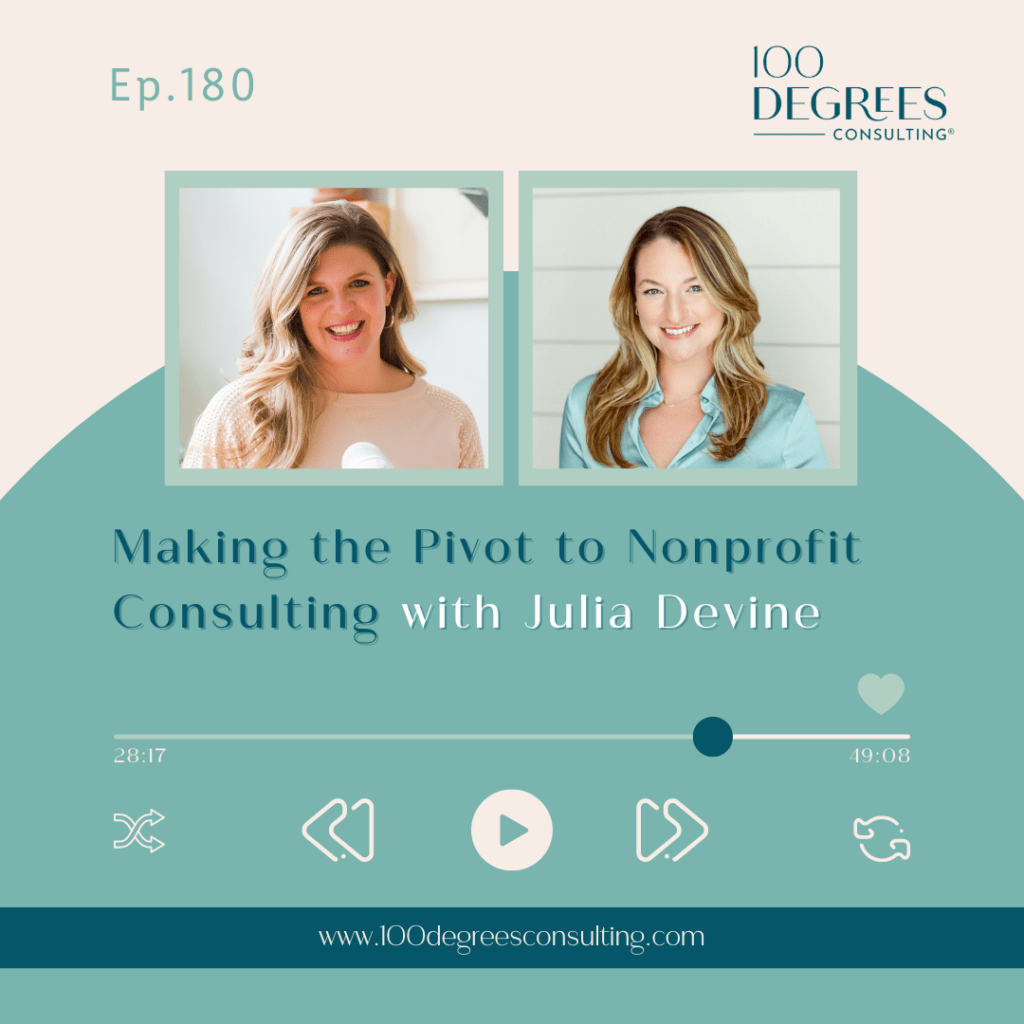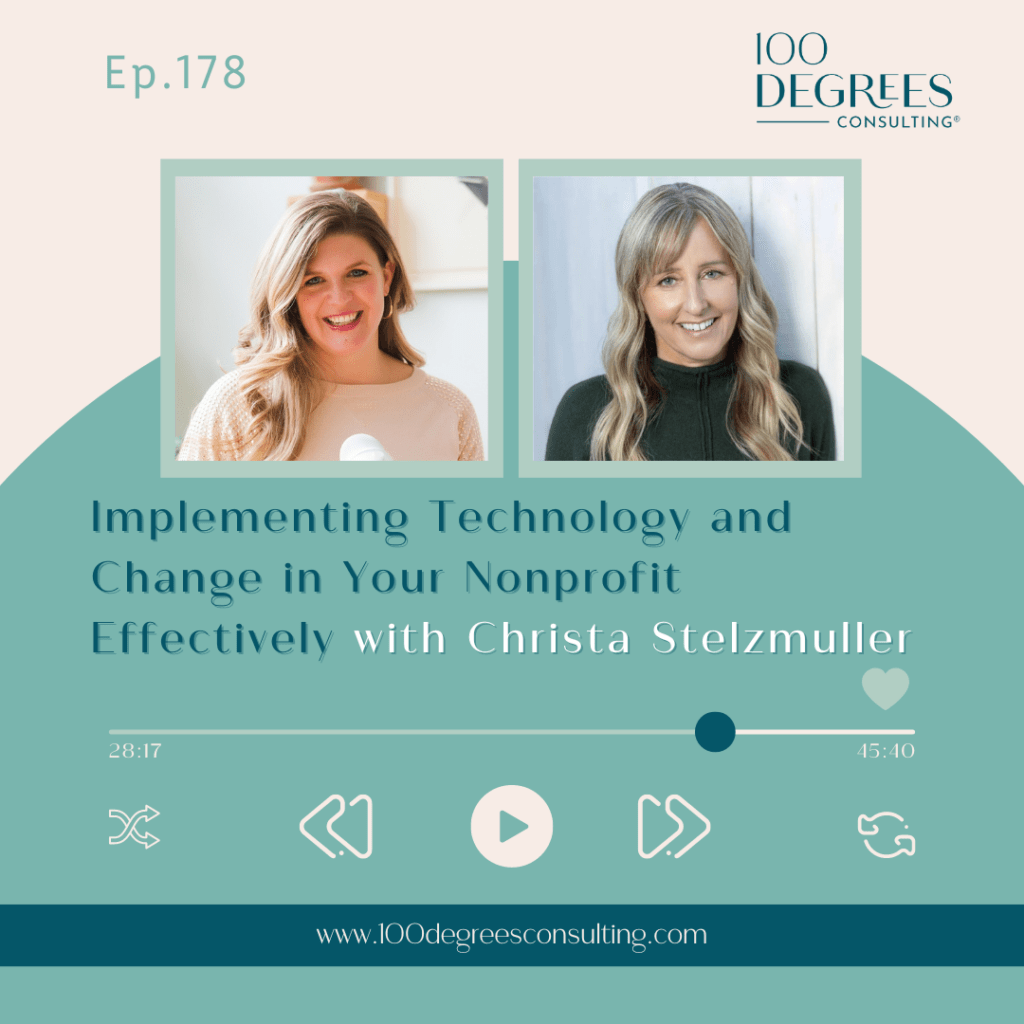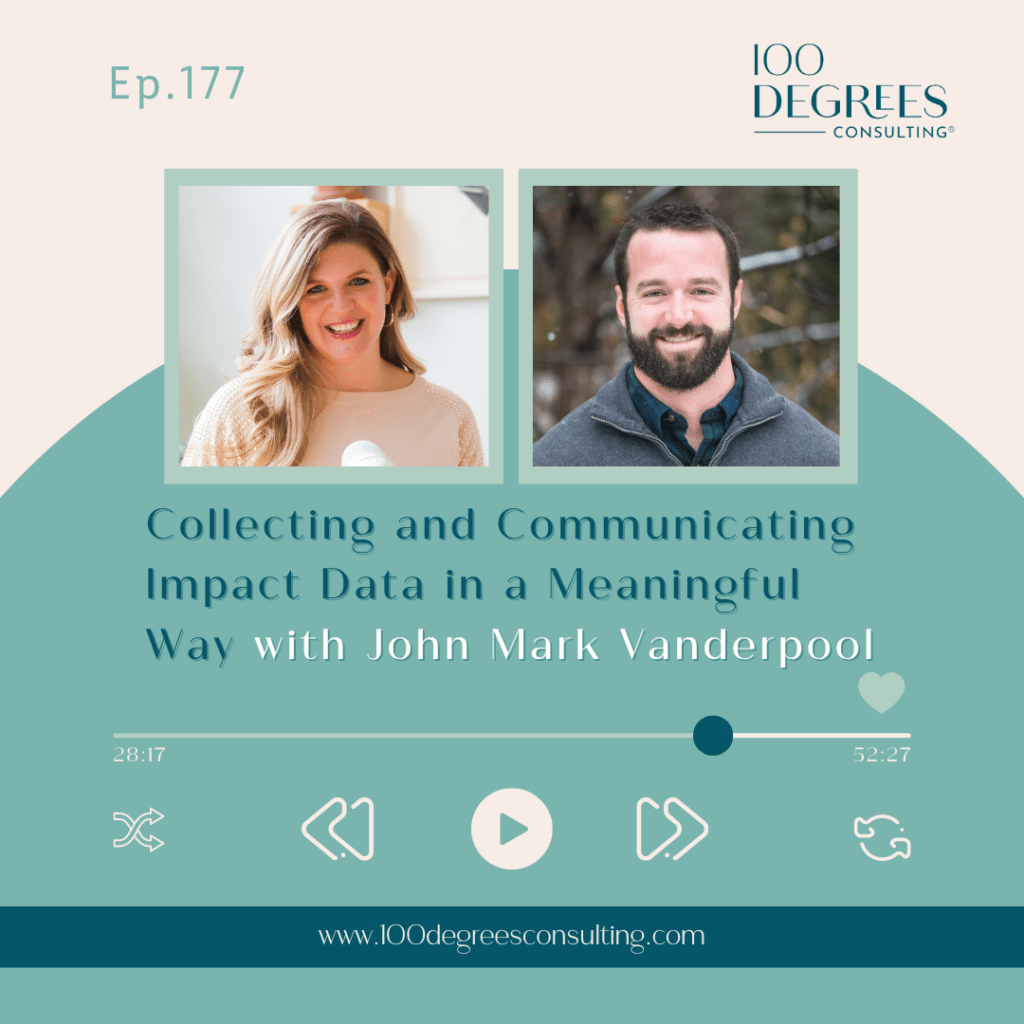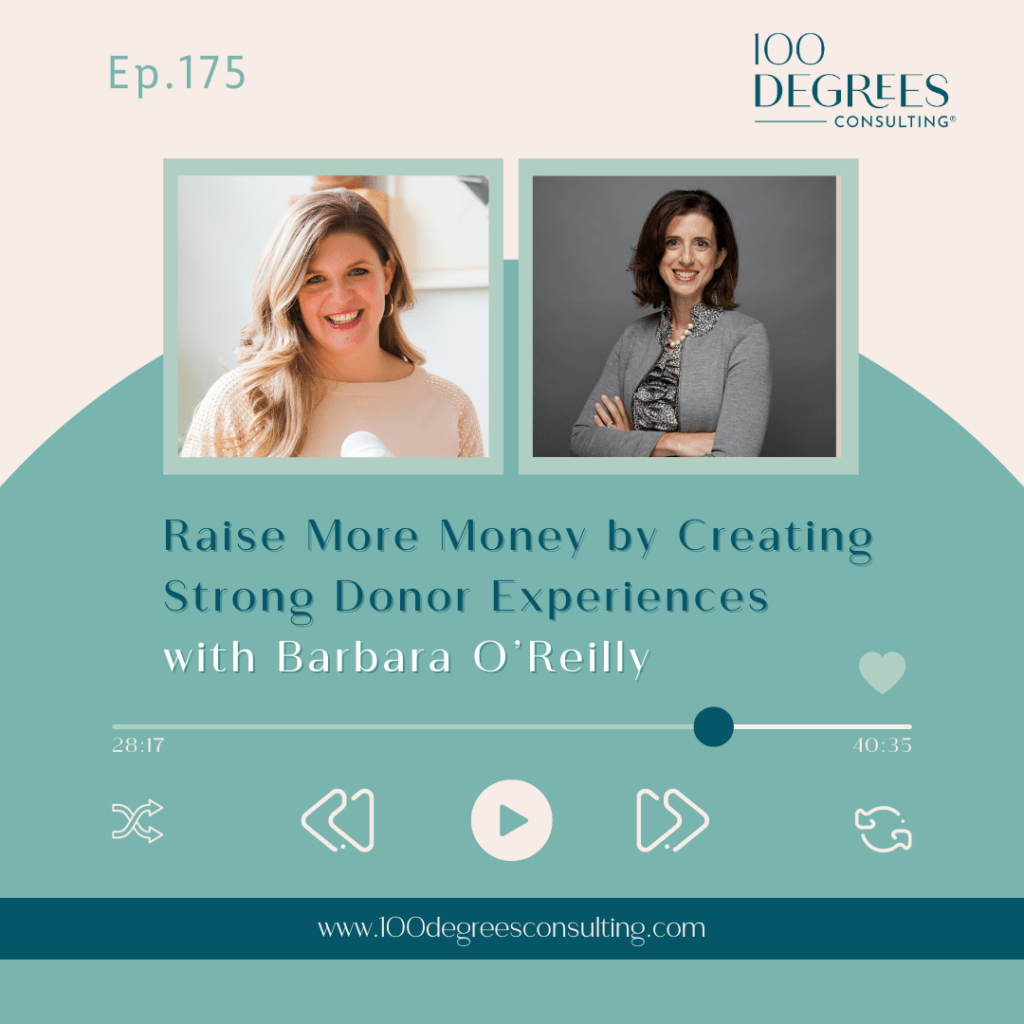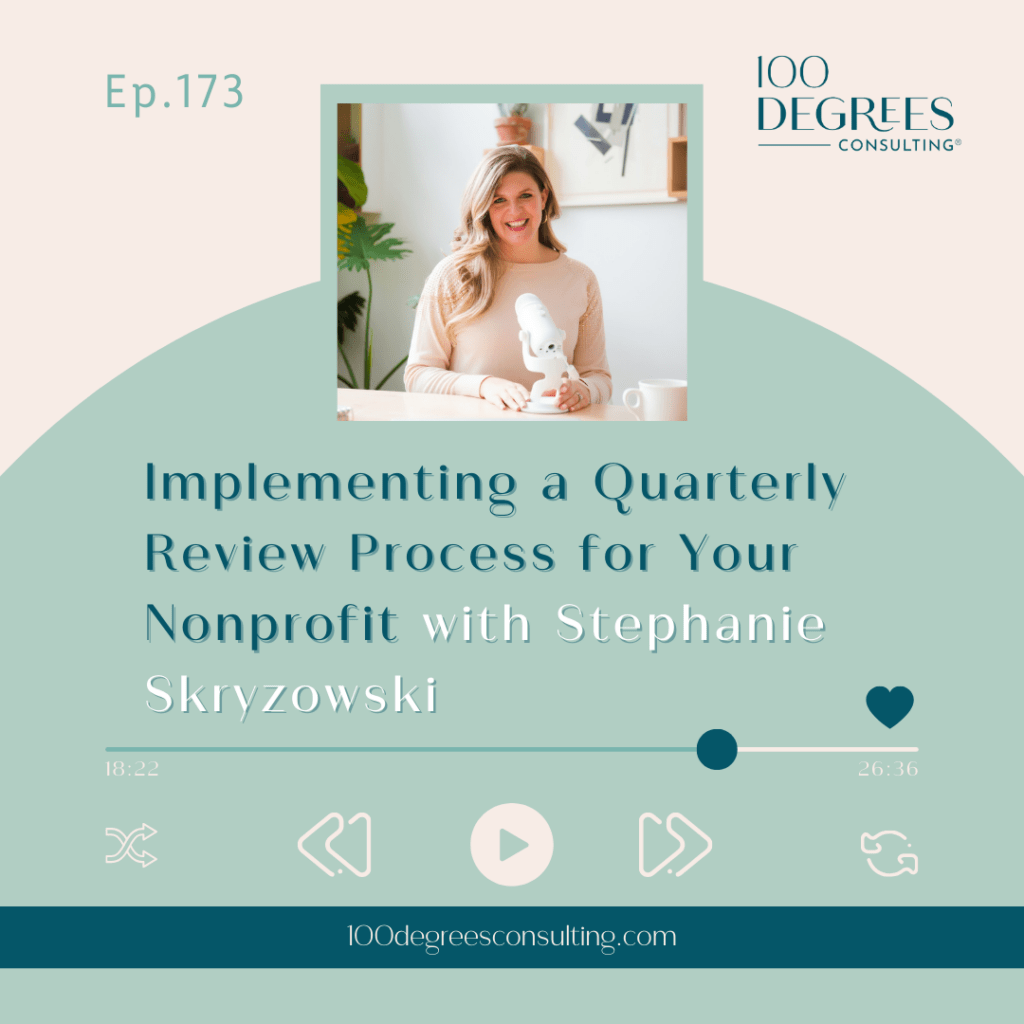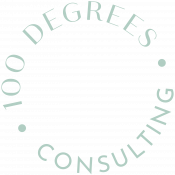Transcript Episode 137 – Leveraging Technology to Facilitate Better Planning with Heather Johnson of Blackbaud on The Prosperous Nonprofit
Stephanie Skryzowski: [00:00:00] Welcome to the Prosperous Nonprofit, the podcast for leaders who are building financially sustainable and impactful nonprofits and changing the world. I’m Stephanie Skrzewski, a chief financial officer and founder and CEO of 100 Degrees Consulting. My personal mission is to empower leaders. To better understand their numbers, to grow their impact and their income.
On this show, we talk to people who are leading the nonprofit sector in new, innovative, disruptive, and entrepreneurial ways, creating organizations that fuel their lives, their hearts. And their communities. Let’s dive in.
Hello, my nonprofit leaders. Welcome back to the prosperous nonprofit. Today we are talking about technology, to be honest with you, when it comes to implementing technology, it’s not really my favorite thing, but [00:01:00] what is my favorite thing is all of the efficiencies and the ROI. That having a solid tech stack behind your organization can do and that the efficiencies that it can generate.
And so that’s what we’re talking about today. We are talking about how important it is and what a critical element of your strong financial foundation, which you know, is something I talk about all the time. What an important part of technology that is, right? Because we don’t want to be sort of buried under mounds of paper and inefficient processes that are really just slowing us down and taking us away from focusing on what matters most in our organization, right?
And so my guest today, Blackbaud, she had an awesome quote in the beginning that she actually attributed to somebody else in her organization. But she said, Let the technology work so you can think or something like that. You’ll hear the real quote in a minute, but I love that. So really [00:02:00] freeing up our time and energy to do the deep work and the important work in our organization and having a technology that can do the grunt work.
So today we’re talking to Heather Johnson and she has spent two decades working with technology for nonprofits, specifically at Blackbaud with experience working with nonprofits at every step of their journey. To revolutionize their organization, she’s come to learn what good looks like and where technology can be the nonprofit’s friend or their worst enemy.
And so we want it to be our friend, right? We want our technology that we are often investing a lot of time and resources into to give us an ROI. So that’s what we’re talking all about today. If technology is not your friend, listen up, this is a good one. And Heather’s going to give us some really great pointers on exactly where to start.
If you’re like, I think our systems kind of feel broken, but I don’t really know what to do. She gives us some tips on the best place [00:03:00] to dig in. So without further ado, let’s go talk to Heather.
All right. Hey everybody. Welcome back to the Prosperous Nonprofit. I’m excited to have with me today on the podcast, Heather Johnson. Heather, welcome. Thank you, Stephanie. It’s great to be here. So Heather and I have collaborated a little bit over the years. She works for Blackbaud and Heather, I will let you explain a little bit about what you do.
Who is Blackbaud? If there’s any listeners listening that have never heard of Blackbaud, you may be living under a rock, but tell us a little bit about what you do, Heather, and a bit about Blackbaud too.
Heather Johnson: Yeah, absolutely. So, Blackbaud, for those of you who may not be familiar, is the world’s leading provider of software for the social goods space.
So, everything from soup to nuts, as they say, in terms of what a nonprofit needs to run its business. So, fundraising, grant management, grant giving, um, uh, Most importantly, my favorite [00:04:00] part is the finance piece, which may seem silly, but that’s, that’s where my heart is, um, and really being really providing, um, solutions for everyone in the social goods space.
Um, I have been with Blackbaud for a little over 20 cumulative years, starting in, yeah, starting in our support organization, um, when I was right out of college and at the time, I really just wanted to. Get a good job, but then fell in love with our mission, our clients, what our clients are doing, and the fact that we only serve the social goods space.
So as a result of falling in love with what we do and the clients we serve, as well as having a really good organization that really was willing to give this girl any chance she wanted, I’ve served in roles from products to sales and services, and, um, most recently I’m going to be managing our partner teams.
So really helping with the extensibility of our platform.
Stephanie Skryzowski: That’s amazing. Oh, I did not know that you’ve been working with Blackbud since you got out of [00:05:00] college. That’s awesome. I mean, and for such a great company and all of the opportunities to sort of try and experience different things. I imagine that you’ve also seen like quite the evolution of the nonprofit sector as a whole because you’ve been working with this company for so long.
What sort of big changes or anything that comes to mind that you’ve seen really evolve over the last 20 years?
Heather Johnson: Oh, absolutely. I think the world in general has evolved to be much more focused on nonprofit or the social good space. And I’ve watched the company grow as a result of that from that, you know, several thousand clients.
I want to say that maybe we were around 14, 000 clients back then to somewhere over 40, 000 clients today. And I think that speaks Not just to what blackboard offers, but it also speaks to the growth of this particular sector, the nonprofit sector. I think there’s much more awareness now for, you know, the Internet [00:06:00] has has helped us become more aware of everything.
And it’s also made it much easier for Individuals and organizations to give to those organizations out there. So as a result, I would say that we’ve we’ve seen the business of nonprofits explode over the last 20 years, and I really believe that it’s just going to continue to grow as folks become more and more focused on social good.
Stephanie Skryzowski: Yeah, absolutely. And Blackbaud provides the technology to help those organizations continue to grow. So one thing that, you know, obviously you’ve worked in the finance space as a CFO and we work with clients on their finances. Having a good technology solution related to your finances is so important for so many reasons.
Um, and Often what we find is that organizations have a hard time investing in the technology solution that they need because it can be expensive in terms of [00:07:00] money, but also resources and time to get things set up and to do things the right way. And after all, this is, you know, I’m using air quotes, like just to back office function, right?
I feel like. Yeah, it can be hard to sort of make that investment. So what would you say to those organizations or sort of like that, uh, that transition we were talking before we started recording, like organizations are starting to see the importance and the ROI of having a good technology solution in place.
Heather Johnson: Yes, we’re really starting to see that change tremendously. So, you know, in my services and sales roles, I have a lot of a lot of conversations with clients who have just made the change to a new platform or they’re considering making the change to another platform, and many times it’s sort of hard to get those conversations going about what’s not working because many times what we hear is Well, that’s working fine.
But then when you start to dig into the details, you’re finding that it’s only working the way that they think it should, [00:08:00] because it’s three FTEs that are making it happen. And in a lot of cases, those folks aren’t even doing the work that they Joined a nonprofit to do, if that makes sense, because they’re so buried in the manual processes, the paper based processes, the report generation, those types of things.
So, as we begin to have those conversations and really inspect those processes, many, many nonprofits are saying, okay, Maybe there is a better way, and the ROI is so much more time back to the organization to actually focus on the strategy of their mission. I have a colleague, I can’t take credit for this quote, and I believe it’s, I believe it’s her quote, but she says, Let the machines work so the people can think.
And that really resonates with me in terms of what we’re hearing from a lot of non profits who do come to us and say, Either we need some help figuring out what’s wrong or we already know what’s wrong and we need a solution to solve these inefficiencies across the business.
Stephanie Skryzowski: Mm hmm. Oh, that [00:09:00] quote is so good.
Like we will definitely, I need to make like a little, a little graphic for that quote. That one is really good. I, um, I love that. So are you finding that once the right technology is in place, it is reducing the number of employee time that is spent on that particular activity? Like, do you find that across the board or like a lot?
Heather Johnson: Oh, absolutely. So I can give you a couple of examples of here. Here are some more great quotes for you. And maybe the nonprofit that said this will actually listen to this podcast. But when we’ve talked about things like the accounts payable automation is a good area, expense management, procurement, report production, we’re finding that as we go through this process of evaluation with these nonprofit organizations, when we start to ask how many hours are being used on these processes.
One client told me the other day, this is the, the quote, is that credit card management, for example, and chasing receipts, he said, is taking [00:10:00] 27, 000 man hours. So that just speaks to the, so probably a pretty big exaggeration there, but it speaks to the frustration that they have in terms of some of these processes.
So when they put an automated tool in place, to solve workflow issues that are paper based and time intensive. What we’re finding is that we are freeing up all of those man hours for those folks to do more within the organization to support the overall mission. It also, we never really like to focus on reduction of headcount in these conversations, but we certainly can focus on maybe you don’t need Additional headcount by putting these efficiencies in place, and there’s there’s also a component there that in terms of the R.
O. I. When you free up these folks who are very talented individuals, they likely came to work for your nonprofit because of your mission when you free them up to play a role in managing to budget managing to grant restrictions. [00:11:00] being good stewards of that reporting function, they’re not only more fulfilled as an individual working for your organization, the organization also starts to see a return on investment because they’re able to look at things like, what is the cost per dollar into our organization?
So what fundraising efforts are actually effective in terms of raising money? and not costing us a fortune. Can we shore up our grant writing resources as a result of, again, freeing up these talented individuals from some of these day to day inefficient tasks they’re a part of? Does that answer your question, Stephanie?
Stephanie Skryzowski: Yeah. Yeah, it does. 100%. Yeah. Cause I think that nonprofit leaders are listening to this and they’re like, yeah, that sounds great. But like, there’s a software that we want that’s like super expensive and we just can’t afford it. But if you sort of shift that thinking and think, okay, we can’t afford it with the current number of employees that we have in our current expenses, but if we were to implement this software, this would then be [00:12:00] able to, you know, redirect three people’s efforts towards maybe more revenue generating activities or towards more program activities but Yeah.
Yeah. Yeah. Being able to redirect effort and not needing to add people as you continue to grow. So now you found some efficiencies because if you can raise more money and do more with the same amount of resources, like that’s efficiency that you’ve gained, that’s a return. And so I love that shift in thinking.
And are you finding like when you’re talking to prospective clients, are you finding that you’re often kind of helping them work through that understanding the
Heather Johnson: ROI? Absolutely. And that is definitely something that we do as part of our software evaluation process and sales of Blackbaud, we actually have a wonderful ROI calculator that we can step through with these organizations and really help them look at each individual process within the organization, how long that process [00:13:00] takes and what the dollar impact is to the organization, because there’s always a dollar impact, right?
Whether they can Okay. See it very clearly or not. It’s there. And then the other thing is that many times it’s a result of a result of disparate systems across their tech stack. So some of that can introduce inefficiency and consolidating those systems into one system. That’s an actual reduction in cost, right?
Like not having to pay for four or five different systems. When you start to get rid of those costs, then the investment in the Core solution, if you will, begins to look more appealing, and then there are also those expenses that we think are relatively small. So paper based systems, for example, when we start to dig into the actual cost of those types of things.
We may be spending far more than we actually realize. That’s also another tool for gaining efficiency and gaining insight where there is waste, for lack of a better word, within the organization, is really having a solution that can [00:14:00] provide reporting that shows you exactly where you’re, you’re spending all the money, particularly on the back office side of the house, because it’s usually pretty clear if you have fundraising events and those types of things, but sometimes those very granular expense details are getting lost in the shuffle.
Because of the lack of good systems.
Stephanie Skryzowski: Yeah. I find that really having that transparency in your numbers is, you know, that helps you tell the story of what’s going on in your organization. And it all goes back to like, if your financial system, for example, if that’s not set up the right way, you are not going to have that visibility and that transparency into your numbers.
So then you’re not going to be able to make really smart decisions and understand what’s happening in the organization. And so it all goes back to. Really have to have that solid like foundation of technology and systems and I think that of course I do. This is my job, but like having a strong financial foundation, including the right technology, the right [00:15:00] systems like you cannot do what you need to do as an organization.
You cannot have the impact that you want to have if you. The back end is broken and I feel like a lot of times it’s sort of seen as like not an extra. We all know that like we need good accounting, but it’s just not prioritized the way that I would like.
Heather Johnson: So, um, a hundred percent and I’m and I’m with you there, right?
And I think it is because when you’re looking to replace a revenue generating platform, like your fundraising platform, it’s so much And I’m using air quotes here. It’s so much easier to make the ROI for something like that, but many times. Obviously, we have platforms that can solve for that piece as well as finance.
Many times when we dig in and we actually start to do the ROI on efficiencies, on inefficiencies or disparate systems, we actually find out that the ROI on the finance side is much larger sometimes than even the ROI on the revenue side. So [00:16:00] that’s, that’s food for thought for sure, because I do think the back office tends to get deprioritized for more of those revenue generating platforms.
Stephanie Skryzowski: Mm hmm. Yeah, exactly. Exactly.
Do you feel like you’re missing something when it comes to your nonprofit’s finances, but you have no clue what you might be missing? I’d venture to guess that one of the reasons you feel overwhelmed and nervous about your financials is because you don’t have a solid monthly routine. So I have created a free finance routine checklist for you.
The spreadsheet will help you know exactly what to focus on. Monthly, quarterly, and annually, so you never miss a beat. Staying on top of your numbers every single month will help you feel more confident as a leader and grow your impact and your income. I’ve made the checklist for you now. All you have to do is use it, gain more clarity into your numbers, more cash and your bank account, and more impact in [00:17:00] your community.
Head over to 100 degrees consulting.com/routine to get the checklist.
Have you seen any examples of how when you have a solid financial foundation, it has actually led to more revenue
Heather Johnson: generation? Oh, 100%. We’ve got many customer stories out there where when they move to a. A solid financial system again. This piece actually goes back to more of the reporting needs that are lacking in some organizations.
It’s both an inefficiency, but it’s also a strategic lack for the organization when they can actually start to create a really finessed motion and cohesiveness between the finance office and the development office or the grant writing folks within the organization. They’re really looking at everything organization.
through the lens of, you know, for lack of a better word in the non [00:18:00] profit space, the P& L, right? And where, where are we seeing the most revenue generation? How do we leverage those efforts and maybe back off of some of the efforts that are not being quite as fruitful for the non profit? So what we see happen is the finance office gets a little bit more involved with development to really look at it through that financial lens.
And figure out how we can be a much more profitable. I hate to use that word because it’s not profit, right? But it’s much more profitable, not for profit.
Stephanie Skryzowski: I know everyone, I feel like we shy away from the word profit, but when I think about it, I’m like, Profit really is just the money left over after our expenses.
And we kind of want some of that, right? Like we don’t want nothing left over after all the expenses go out the door. I know, but it’s like the dirty word in, um, in the nonprofit space. Yeah, I think that’s huge. And I’ve seen that as well. Like when we have better financial reports, faster financial reports, that only [00:19:00] makes us look really good to our donors and to our funders.
And so they’re going to be more inclined to. You know, continue to fund us to renew that grant because, hey, we know this organization is managing their money really well. They’re super reliable when it comes to reporting. They’re a good partner. Let’s give them more money. Like I’ve seen that happen time and time again.
So I love that. I was just thinking of this example, and I think I mentioned this on another podcast episode that I just recorded, but speaking of processes. There was one organization that we started working with that they would print a paper check and then somebody from their office would literally get into their car, drive across town to have their board member sign the checks and then come back and put them, you know, organized, put them in the mail and whatever.
And I mean, that’s like hours of lost time and inefficiencies. And so when you put a dollar amount on that, that’s a lot of money lost because we don’t really have a very good system. I think that’s huge.
Heather Johnson: [00:20:00] Absolutely. We hear similar stories, maybe not to that extreme where they’re driving across town, but that is one thing that I definitely see as a mindset shift that we’re working through in this space.
So, again, not the extreme of driving across town, but certainly. Printing off that pre check register, having the CFO review it, signing the checks, and some of that, honestly, is the concern around having a good audit trail and dual controls. Absolutely valid, right? We’re both in the accounting world. We know without good dual controls, it can have disastrous effects on an organization, but where we’re seeing the shift is More and more nonprofits are becoming okay with that electronic audit trail for things like this.
So, using electronic signatures in conjunction with really good controls. And yet again, when we go back to allowing the organization to be more strategic, that CFO is freed up for three or four hours of the week, whatever they’re spending, [00:21:00] to be able to work with the development office, to provide more transparent reports for their donors and funders and that type of thing.
That was a great example.
Stephanie Skryzowski: Yeah, I’m like, oh, paper, if we could just have no more
Heather Johnson: paper, that would be fantastic. Agreed. Um,
Stephanie Skryzowski: and you know, it actually, I feel like in, to some degree, we sort of, because we are a fractional, entirely remote solution for our clients, we kind of forced them to be paperless. Because, well, you know, I’m not near your office.
I can’t sign anything. So we got to figure out a way to do this electronically, or this is not really going to work out. So we kind of have to force that sometimes, but I think it’s, it’s for the, it’s for the greater good. Um, so if an organization is listening to this conversation and they’re like, Ooh, I feel like we may be.
10 years behind and we need to start thinking about like, where can we find more time and resources by building out our systems and our software and our technology? What would you say [00:22:00] is, where do they start? Like, what is a good place to begin if they’re thinking that there’s some inefficiencies that they want to work on?
Heather Johnson: I think that actually begins internally with the organization. I’ll take my sales and services hat off for a moment and really focus on the organization itself. If they know that there are sort of some red flags with their processes, it’s a great thing to sit down with the team and listen to the team, quite frankly, because before you begin any software evaluation, you want to make sure that you have the team’s buy in.
I always say that Every platform is only as good as its level of adoption. So by sitting down internally and reviewing your business processes, that accomplishes a couple of things. The first would be that you’re going to become aware of inefficiencies. You as the leader of the project are going to become aware of inefficiencies that you may not have even realized they were out there.
That the folks in the organization, they’re just showing up every [00:23:00] day, they’re doing their work, they’re getting it done. And then when you start to sort of, Peel the layers of the onion back, you discover that actually, you know, Mary in accounts payable, right, is spending way more time than she should be in specific areas.
That allows the organization to really take a look at what processes are in efficiency. It creates that buy in from the team that yes, we’re going to give you so much time back that you can get an extra cup of coffee, or take a lunch, or go home at five o’clock so that you can be with your family. And they really, they feel seen, they feel heard, the organization has a better understanding of all of the inefficiencies throughout, and you can go to that technology provider and say, these are the things that we have already identified as pain points.
Help us understand, are there more that we’re potentially missing and what can you do to help me solve these particular pain points that we already know about?
Stephanie Skryzowski: Mm hmm. I love that the place to start [00:24:00] is with the team. And I feel like, I feel like I, I definitely, I’m thinking about my own business and like some of the things that I’ve done over the years and put into place.
I’m like, Ooh, that one project management system that we did. Yeah. Probably should have liked. Started with the team. Um, so I think that’s fantastic because you’re right. They’re going to be the ones that will tell you, yeah, you know, I learned this process from this person, you know, my predecessor, and I think she learned it from her predecessor and like, it doesn’t really make sense, but I just did it because that’s what I was trained to do.
And I feel like there’s a. A lot of that, these processes that were handed down from like team member to team member as people left. And then you look back and you’re like, wait, that actually makes no sense why we’re doing it
Heather Johnson: this way.
Stephanie Skryzowski: So your team is like the most valuable resource of like, all right, what could we, what could we do here?
What could we do differently? Because I love this quote that you said, any platform is only as good as its level of adoption. And like, [00:25:00] That’s genius. I love that. It’s so true. So true. So, okay. So. We’ve started with the team and now we’ve like everybody’s on the same page on like, okay, here’s some inefficiencies that we need to address.
Then what’s next? Do we go to Google? That seems slightly overwhelming, but maybe, but maybe
Heather Johnson: yes, what’s next? So, I mean, certainly that could be one way that you start, but there are some sites out there like software advice is one. Um, you know, we, we sometimes see some things come in from software advice.
I’m certainly looking for. If you’re going to go on a search, you know, perhaps consult your your accounting firm, they can sometimes help you find a solution beginning the search online. I would be certainly sure to make sure that you are searching for solutions that serve a nonprofit organization and not a massive commercial system.
Um, now, obviously, I’ll just state that I’m, I’m quite biased here because I truly believe, truly believe that [00:26:00] Blackbaud’s products serve the nonprofit much more. So then a commercial system, but there are reasons for that, right? Nonprofits have very specific compliance and reporting needs. They need to be able to be accountable to our donors, to our grant funding sources.
Um, if they’re giving out grants, they certainly need to be able to show the outcomes of them, or the The impact, I should say, to the communities that are receiving those grants. So I would really begin the search through that lens of, I need someone who really understands the social goods space, what we’re doing there, and can solve for those particular needs.
Is that a good starting point? Yeah. Yeah.
Stephanie Skryzowski: Yeah, exactly. Yeah. I think making sure that the solution that you’re looking at is aligned with, you know, your organization and your purpose. I think that is, yeah, I think that’s super important. Fantastic. Well, okay, I have two more questions for you, but the first is I like to ask all of our guests this, um, what does a prosperous nonprofit look like to you?[00:27:00]
Heather Johnson: So I actually wrote down five key words for this particular question. Yeah, so I’ll go if it’s okay, I’ll list those off and then I’ll talk a little bit about what I see in each of these areas. So a prosperous nonprofit is compliant, they’re efficient, they’re transparent. Um, that’s sort of the same thing as compliance, maybe strategic and so I’ll.
I’ll kind of take each one of those through the lens of what we typically see. So compliance, as we know, living in the accounting world for, for most of our professional life, it’s so important for a nonprofit organization. You mentioned it earlier in terms of, you know, being a good steward and how that actually drives revenue up for a nonprofit organization.
If you are a compliant nonprofit, you’re going to receive more grant funding because a part of the grant application process is being able to show. Your [00:28:00] financials and that you were good stewards of what you’ve already received. You’re going to be compliant to donor’s wishes. So I think of organizations who are major giving organizations and they’re receiving sometimes very, very large gifts that are going into endowed funds and that type of thing.
They’re compliant to a whole different set of stakeholders, right? So it’s being compliant to your internal Stakeholders, your external, the board, your donors, your grantors, fill in the blank. Efficiency allows us to be more compliant. We can spend more time making sure that we’re adhering to donor wishes.
grantor guidelines and so forth. Transparent, I think we probably all know what that means. If we’re not a transparent organization that can demonstrate what we’ve done with past dollars given, we’re less likely to receive the future dollars that could come into the organization. And strategic, this goes back to what we’ve talked about a couple of times in today’s session, is, is the organization really almost [00:29:00] behaving like a Like a for profit in some ways.
Are we looking at those cost reduction areas? Are we looking at those inefficiencies? Are we looking at cost per dollar into the organization to determine which? Which areas are the most profitable and then finally outcome driven outcomes seem to be that seems to be a buzzword right now outcomes outcomes outcomes, but I think it’s a great thing we we actually start our process of software evaluation here at Blackboard looking at the outcomes the organization wants to produce and then we kind of back our way into a solution.
We do the same thing during implementation and what we’re also seeing is that we’re seeing nonprofit organizations. Who are very fruitful? That’s their approach as well. What are the programs we want to support? What is our mission? What’s the outcome we want to produce? And as a result of looking at those things first, they’re able to back their way into the strategy of the organization, their technology stack.
And at the end of the day, [00:30:00] those are the types of things where they’re able to actually go back and produce those outcomes to the communities they serve, which in turn prompts those communities to give back to the organization.
Stephanie Skryzowski: Hmm. Yeah. Oh, I love that. That was probably the most prepared answer that anyone has ever given me.
And I love it because it’s so good. All those things are, are so true. It’s so interesting because I’ve asked that question so many times to all of our guests now and never once have I gotten the answer like, well, a prosperous nonprofit has like X number of dollars in the bank. Like that’s not, that’s not really what it’s about.
And so I love it. That’s right. And so. Yeah. Thank you. Fantastic. Fantastic. Well, Heather, thank you so much for chatting with me today. I think this is going to be just such a useful conversation for our listeners. If our listeners are intrigued and they’re like, okay, I need to know all about Blackbot if they’re not already familiar with you, where can they go?
Where can we go to learn
Heather Johnson: more? Certainly, you can find us at blackbaud. com. Very simple. We’ve got links to all of our [00:31:00] solutions, our services, our partner marketplace. We have fully extensible solutions. There’s a lot of customization and integration you can do going back to that tech stack that we don’t want to be complete disparate.
Um, and certainly feel free to reach out directly to me and I can point you in the right direction. My email address is heather. cooper. Johnson at Blackbaud. com. Fun fact that we have multiple Heather Johnsons at Blackbaud. So wow.
Stephanie Skryzowski: So not just Heather, but lots of Heather Johnsons. That’s funny. Yeah. So funny.
Well, Heather, thank you so much. I really appreciate you being
Heather Johnson: with us today. Yeah. Thank you, Stephanie. Thanks for having me. This is great.
Stephanie Skryzowski: Before you go, I just want to thank you for being here. To access our show notes and bonus content, visit 100degreespodcast. com. That’s 100degreespodcast. com and I’ll see you next time.[00:32:00]


